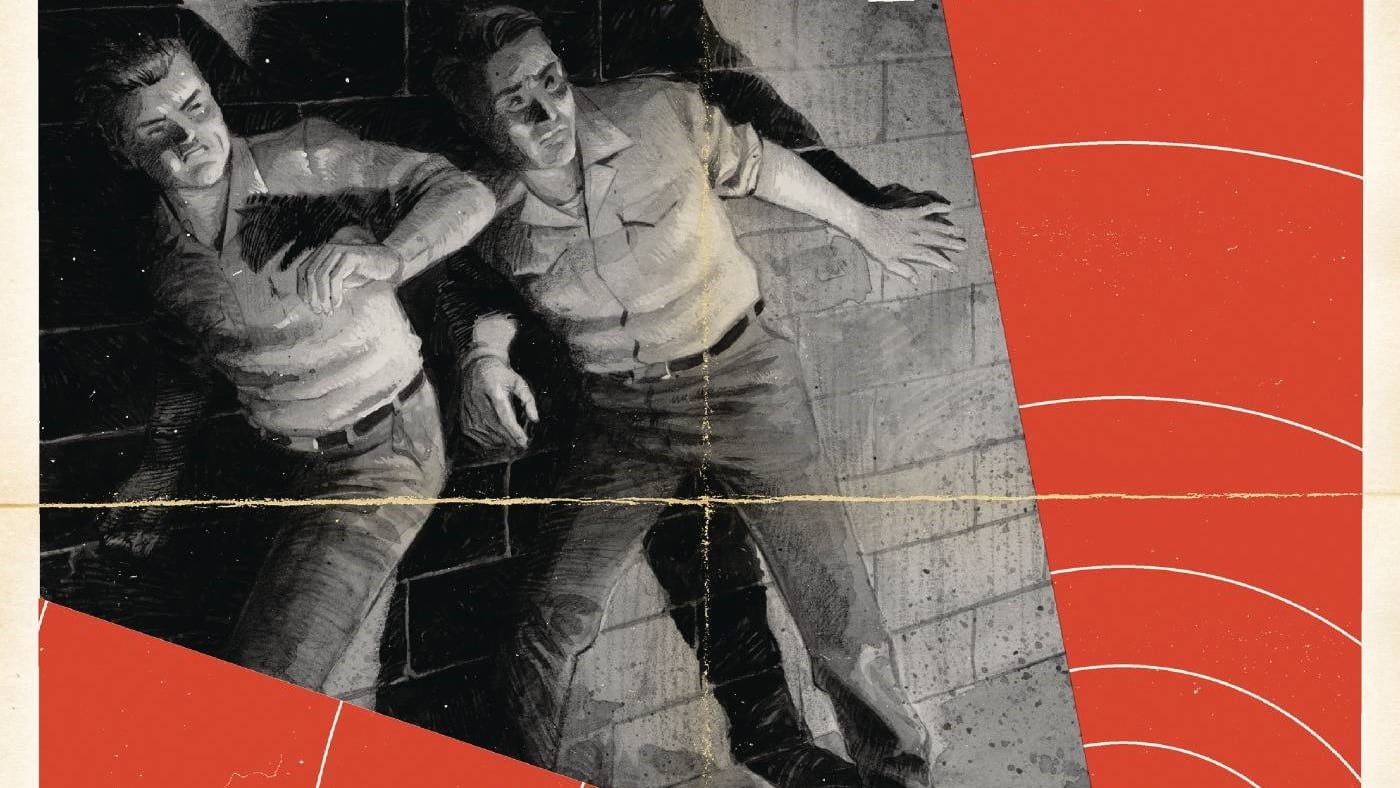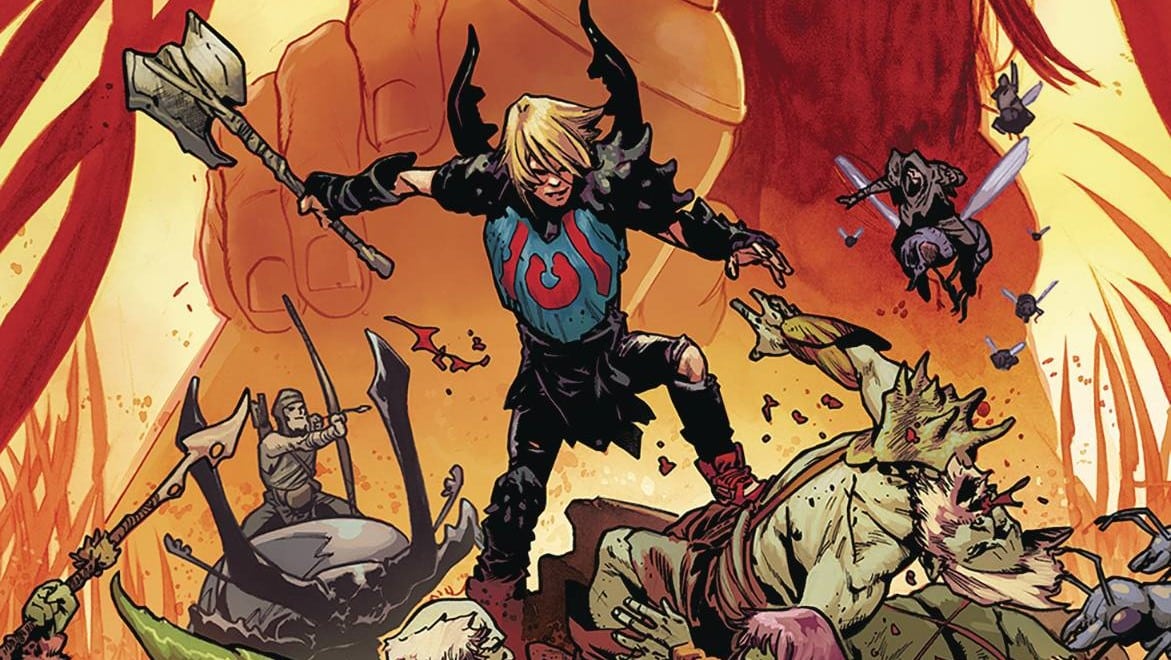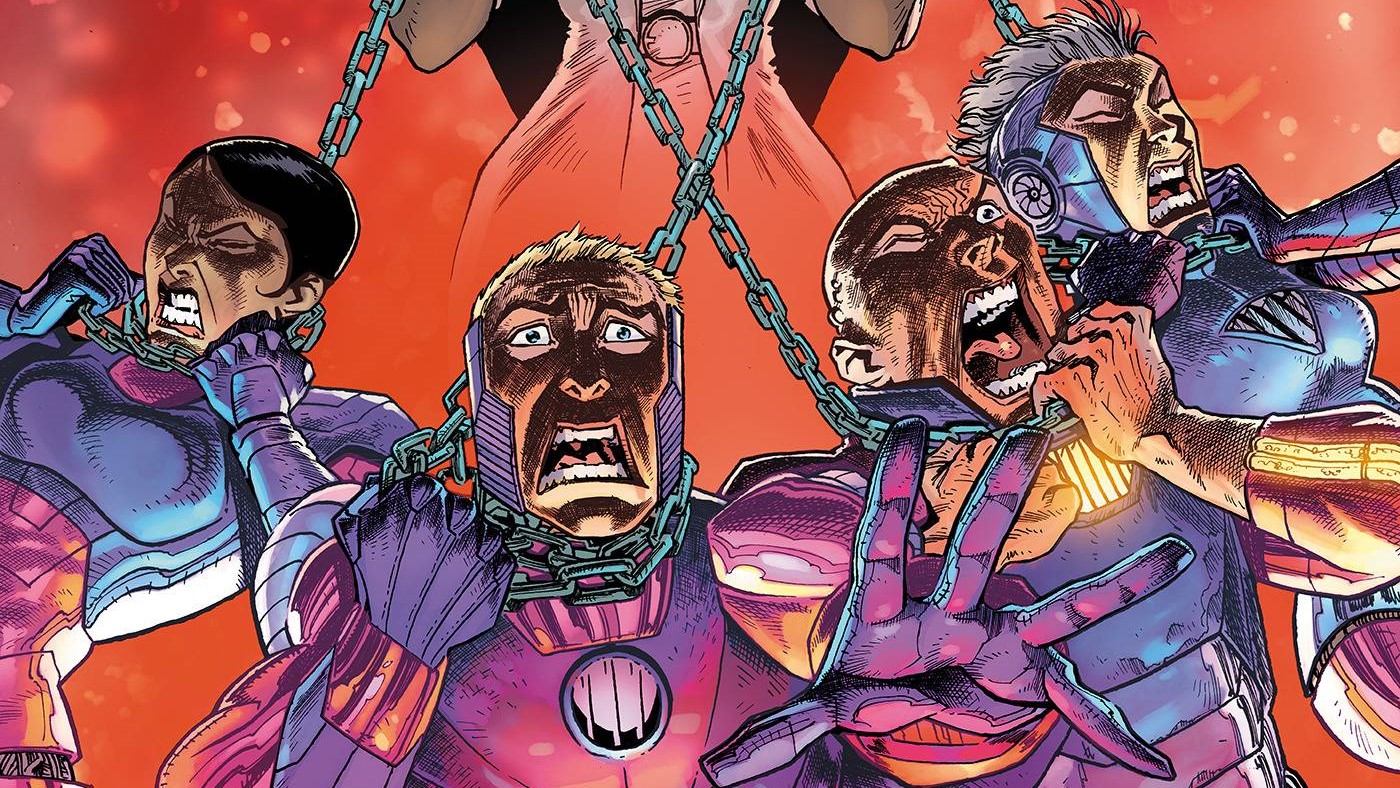The final showdown between Malik and Richter has begun on the surface of the god they’ve discovered. But will Malik survive long enough to find a living god, or has he doomed his crew to an unimaginable fate? Those eight bells mean it’s time to break down BOOM Studios’ We Only Find Them When They’re Dead #4 by Al Ewing, Simone di Meo, Mariasara Miotti and AndWorld Design.

Chris Eddleman: Andrea, it is time once again. A time for space, a time for gods, a time for discovery and a time for death. That’s right, we’re back with another in-depth look at We Only Find Them When They’re Dead, and I’m excited to talk about it with you. This issue was rather scant and a bit decompressed, unfortunately for our kernel of discussion potential. Granted, I can talk all day long, and I’m sure we have a lot to dig into.
Andrea Ayres: Chris. ‘Tis the season for talking about choppin’ up space gods. You know, I’m not entirely pleased with what I’m about to say here, but I’ll say it anyway. When I finished issue #4, my thought was “Hrm, OK.” This may be sacrilege, but sometimes I feel that people’s general approach to WOFTWTD has a tinge of hagiography to it. As a trade paperback, I think it will work because it feels like a very experiential piece that needs to build on itself over time. I can’t say breaking it down issue by issue has done it any favors.
Time Is a 12-Panel Grid

CE: So we begin our comic hanging on the cliff the last issue left us, but instead of diving right into the state of poor Alice after Paula’s invasion of the ship, we get a series of flashbacks. These are arranged in a grid and act as sort of a logical conclusion to the time jumps we’ve seen previously, but instead we get quick panel-by-panel changes in three sets of time. This was kind of challenging for me to parse, which is not say anything about their craft, just that I had to go back and read those pages a few times. What about you, Andrea?
AA: I am glad you say that, because I had the same feeling. You know the saying “too cute by half”? My mom used to say that to me when she thought I was trying to be too clever and overcomplicate something. I don’t think the visual hierarchy makes a lot of sense. It feels confusing in a way that isn’t necessary. I mean screw me, right? I’m not the one writing this, so who am I to say anything? I’ll admit, sometimes I feel like maybe I don’t know enough about comics to get stuff like this. So it could be doing something playful that is just beyond me? Like I know it’s Georges and his brother (who looks like a Disney prince), it’s not that any of the storyline is hard to parse per se. It is that I don’t know why the panels are laid out this way. Is this making any sense?
CE: So I think the main crux of this layout is supposed to represent the cyclical nature of “The Quest” that Georges is obsessed with. His mother was obsessed with it as well, and passed said obsession on to him. But instead of a cycle of progression, it’s a cycle of loss, as Georges has lost his mother and his brother in his pursuit of this mystery of deceased deities. But otherwise, I think it doesn’t quite portray this as well as it could, especially with the repeated panels. Were they supposed to be internal progression, or a freeze frame? I found it a bit muddled, even if the cyclical theme was present.
On! On! The Glorious Narrative!

AA: Sometimes I get the feeling that these characters are more realized in the mind of the creators than they are on paper? Do you feel this way?
CE: I get what you mean. I’m a big fan of Ewing’s characterizations in other titles, but I really think these characters haven’t had much time to breathe, as the very decompressed nature of the narrative means we are barely getting much of them at any given time. What we get, I like! Remember issue #2? That had some nice characterization. But otherwise I’m feeling like they’re fairly flat. Alice, particularly, gets very little to do other than be a quest accessory. I almost hate to say this considering how confusing I found some of the flashbacks, but I could have used more backstory, to be honest. Or maybe just more conversation. This comic has a lot of big stylized panels, and I wouldn’t mind more words.
AA: The treatment of Alice! Poor Alice. She loved Georges so much. It feels like Malik has been surrounded by people who loved him his entire life but he can’t see it. He can’t reach his hand out and grab it. Sometimes guilt works that way, especially if you aren’t willing to face yourself. That could be one possibility for why the flashbacks are confusing. We’re only seeing what he’s allowing himself to see and realize. It’s been a slow process for him. Might this explain the hazy quality of the flashback scenes?
CE: I think that’s a solid speculation. I’m pretty fascinated with the unique perspectives of the non-Georges characters, even if they’re fairly simple. They simply show different ways of interacting with an obsessive person: hostility, indifference, support and devotion. But you’re right about Georges. I enjoyed the poignance of him going EV to rescue the dying Alice, but then immediately forgetting about the death of the person most devoted to him when the ship accidentally sliced the throat of the awakening god. The quest rules all, and I think that’s probably the thing this story does the best.
AA: I also agree with you about issue #2; it was the scene where we have characters literally up and moving around. I can’t figure out exactly what is misfiring for me about everything here. There’s a discord, and it may be intentional, but I’m almost upset that I don’t know these characters enough by now. Which feels totally ridiculous to say. There’s got to be a reason for this, right? Like in no way do I believe that Ewing doesn’t know what he’s doing with this. So I don’t know where that leaves me, Chris. Help!
CE: I think this is a series that doesn’t benefit as well from issue-to-issue scrutiny, a thing we are definitely doing. [Grote’s note: Uh-oh.] But I just think it’s a story told in a decompressed way, but with art that doesn’t assist with the decompression. It’s hard to see at times, as any sort of panels of motion have a blurring effect, which just ends up muddling the impact. I think di Meo is a talented artist, but I think these talking heads followed up with blurred motion action is not doing us any favors. As for a discord on purpose, I wonder if that’s because we are supposed to see these characters mostly from Georges’ perspective, and how he sees them as means to his end.
An Autopsy

AA: An autopsy ship. How many times have we heard this refrain? Eight bells. A ship’s end of watch. What if — and please don’t think I’m totally outta control here — what if Georges is already dead? Is this like in the movie Contact where we are going to be left wondering if any of this ever happened? Was it real, and if it was, was it about aliens or was it about finding salvation? [Grote’s note: Do you mean … A JACOB’S LADDER SCENARIO?!]
CE: This is the speculation that I very much enjoy. The repetition of certain phrases — “Eight bells and all’s well, the knife is sharp and ready for work, etc.” reads like a mantra, which adds to the cyclical nature of the past intersecting with our current narrative. It also reads like comfort phrases, familiarities to Georges. I’m not certain if he’s dead, but it’s interesting to speculate. I certainly think something is afoot as we see the last gasps of a barely woken god, and the barrel of a sniper rifle held by a woman bent on hopeless revenge.
AA: The thing that’s going to happen here, Chris, is that at the end of this series, I know I’m going to be like, “It was right there in front of me the entire time.” I will feel foolish, the way Ewing tends to make me feel when all the narrative threads come together and I sheepishly head back into my corner and nurse my wounds. MY WOUNDS. Will Georges and Paula end up killing one another? Are they the same person? Is this a double bind? Help me.
CE: I feel the same way. Am I simply being punked? Is this more allegory than I’m seeing? It seems to have maybe abandoned the Kirby allegory that I was seeing early on, even as a fruitless Moby-Dick-esque lost cause quest seems to be more our speed. But who knows? Maybe this last issue is going to throw us for a loop, and we’ll feel so silly for hitting this issue by issue, even though it was the way it was presented. Hard to tell! Who knows! In for a penny, in for a pound (of yummy god meat)!







